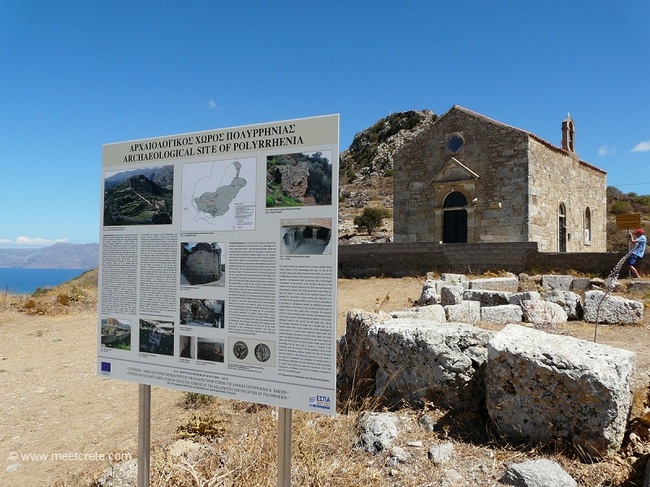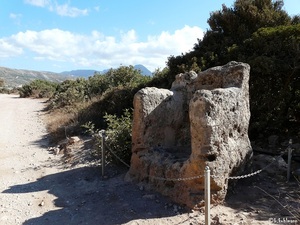Duration: Full Day Tour (5 relaxed hours + 2 hours beach)
- Duration of the tour: 5 relaxed hrs plus 2 hours on the beach
- Kilometers: To/from Chania ca.120km
Road Trip West Crete – Sightseeing en route
- Polirinia village and ancient sites in the village
- Ancient site of Falasarna
- Falasarna Beaches
Note: from the beaches of Falasarna to the ancient site Falasarna it is about 1km on a dirt road which is good to drive on.
Click the button to print the map
Road Trip West Crete – Ancient Polirinia
The 40 km of panoramic National Road from Chania to Kissamos runs mostly along the coast. Before the downtown area there a sign on the left side which leads us to the road going south: “Ancient Polyrinia 7 km”. A fairly narrow road partially fringed by cypresses takes us through a few small villages all the way to Polirina. We park our car in the at the village entrance next to other vehicles.

A little history
A few explanatory words about Polirinia.
There you can experience a rare scenario: a Hellenistic city with walled ruins and Roman cisterns, ancient tombs and contemporary homes. At least four ages live in peaceful harmony with each other, as building materials for the “Church of the 99 Saints” and for some of the houses were building blocks, marble and columns from ancient times.
Polirinia, built about 1100 BC., became the second most powerful city in west Crete (after ancient Kydonia, now called Chania) and even had its own coins. Even King Agamemnon is said to have offered a sacrifice to the goddess Artemis Dyktina after his campaign in Troy here in this ancient city.
Walk through Polirinia 
The present village numbers about 100 inhabitants. On our way to the Acropolis we meet an English woman, Jane, in the “Old Cafeníon”. She says she has lived here for 9 years, manages the Cafeníon and is also involved with agriculture. She is pleased with every visit.
Further up the hill we suddenly hear men’s voices and music, and we see foresee one or two filled shot glasses for us.
Giorgos, an olive wood carver, invites us to linger, and we accept his offer with thanks. Yamas (Prost) we exclaim as the Tsikoudia runs gently down our throats. The sliced tomatoes from his garden taste great. Soon we begin to philosophize about our lives. He says that through his work with the olive wood he feels that he is leaving something permanent to the world. We agree with him, and when we get up with a heavy heart, he puts a carved salad spoon in our pocket.
Efharistoume para poli (many thanks) until next time. Time to go, the ancient footpath along the Acropolis on the mountain peak waits for us.
The merciless midday sun (or maybe the booze?) plays a trick on us. We arrive at the “Church of the 99 Saints”, enjoy the view and turn our back to the Acropolis … we will leave the climbing for the next visit.
Road Trip West Crete – Continue west to Falasarna
The most practical route would just be a shortcut through the mountains to the sandy beaches of Falasarna, but as the roads are meant only for the locals they are poorly written or not marked, so we gladly give up this adventure.
Back to Kissamos and further west we pass the fishing harbor with its fish taverns and the port for the boat excursion to the pirate island Gramvousa and the beautiful bay of Balos, and then through the small village of Platanos to Falasarna. [/mks_one_half] [/mks_col] I have been here for countless times for sure, but each time as the valley is spread way down in front of me, I relax suddenly, and the car almost rolls down alone. The islet Pontikonissi is now razor sharp in front of us, and even the island of Antikythira towards Peloponnese is clearly visible, a rare sight.

Road Trip West Crete – In the port of nymph Falasarni
Named after the nymph Falasarni, the area was in ancient times not famous for its beaches, but for its artificial canal, which afforded a safe anchorage to ships and allowed the city to become a maritime power.
Numerous pirate ships found undisturbed refuge here. To prevent this, the Romans destroyed the city in 69 BC, blocked the harbor entrance and sealed their doom. In addition, in 365 AD, the tectonic plates lying beneath the island’s shifted and Crete was shaken by a severe earthquake. West Crete rose up to 9m from the sea, and the the port facility of Falasarna was on dry land ….. the remaining inhabitants of the former famous port city left the area.
We leave the beaches on our left and follow the dirt road up to the large stone resembling a throne which probably served as a speaker’s platform, and continue for another 100 meters to the main entrance of the archaeological site .
For 2 years the excavations are progressing in rapidly, and with each visit there is something new to admire. And isn’t it always an experience to walk on the same ground as our ancestors from ancient times? We stroll through the former port facilities on dry land, paths lovingly framed with stones leading us from one excavation to another. There are no guided tours, imagination has free rein here.

At the beaches of Falasarna
Slightly exhausted, we look at each other, a nod is enough, and in 10 minutes we have parked above the middle bay of Falasarna. It is obvious why the local beaches have been repeatedly selected as the best in Greece, and even CNN has it listed in 2013 among the 100 most beautiful beaches in the world. Crystal clear turquoise waters always cool, and beaches some with coral pink colored sand, the mighty mountains on the north side, and finally an often intoxicating sunset … I guess that sounds great, right?
- Read more about the beaches of Falasarna in Falasarna – endless sandy beaches on the western end of Crete
Road Trip West Crete Falasarna – Useful information
If you are strongly interested in visiting the ancient port Falasarna, best show up there until 14.00h, afterwards the fence might be closed. Archaeological sites (if not mentioned differently) use to close at 15.00h.



